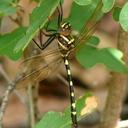United States and Canada
Though uncommon, this is the brightest and most-vividly marked river cruiser in our area. It has a yellow vertex and narrowly interrupted pale abdominal spots. The frons is yellow on top except for a broad medial dark stripe on the sulcus. The thorax is dark brown with well-developed full-length antehumeral stripes. The wings are clear, though sometimes tinged with yellow, and have distinct basal brown spots. The legs are dark brown or black. The abdomen is dark brown or black, strikingly marked with yellow on segments 2-9. These spots are often thinly interrupted middorsally on segments 3-6.
Size: Total length: 62-70 mm; abdomen: 45-51 mm; hindwing: 40-46 mm.
Similar Species (south-central US): All other river cruisers in the area are more dull in coloration. Bronzed River Cruiser is much duller, lacks brilliant green eyes and has spots on segments 2-6 that are connected medially.
Habitat: Moderate-sized streams and rivers with pools and areas of slow flow.
Natural History: Individuals in the southern part of this species' range are on average smaller than more northern individuals. Williamson (1909 ) stated "The flight of pacifica is generally less swift than that of taeniolata and...[it] ranges less widely, patrolling possibly only one pool, while others return to the same point only after longer intervals." This species is not common in the south-central United States, but does apparently hybridize with Royal River Cruiser. These hybrids have been referred to as M. wabashensis Williamson and are known from Texas and Oklahoma.
Distribution: Eastern, Ohio to Texas.
Source: Abbott, J.C. 2006-2010. OdonataCentral: An online resource for the distribution and identification of Odonata. Available at OdonataCentral.
Edited by Drew Weber (9/24/2015).
